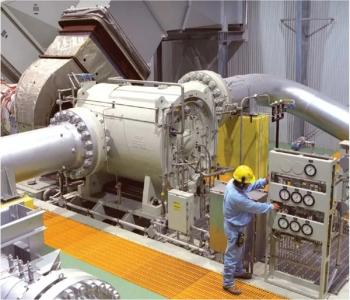
- September/October 2024
- Volume 65
- Issue 5
Myth: Part 1: A Centrifugal Compressor Map is Just Test Results
Part one of this two-part myth on a centrifugal compressor map covers the basic physics of the constant speed head-flow performance lines.
Most engineers that work with turbomachinery are fairly familiar with centrifugal compressor maps. These maps usually show dimensional head, pressure ratio, or pressure versus flow for various speed lines. Sometimes engineers also use non-dimensional maps that show non-dimensional head coefficient versus flow coefficient, usually on a single line. The dimensional maps also always show a flow-limiting surge line and sometimes a choke restriction line. Some compressor maps may even show efficiency lines that form “islands” around the best efficiency point on a dimensional map. Whether one uses dimensional, non-dimensional, head-flow, pressure ratio-flow, or pressure-flow maps is a matter of convenience since all these maps, if accurately drawn, show identical information and can easily be converted from one to another.
Surprisingly, there is little understanding among industry as to where these maps actually come from and what their underlying physics is. The usual answer I get from engineers is they come from “testing”—while technically correct, it isn’t a very satisfactory response and provides no insight whatsoever. Don’t get us wrong, most compressor maps supplied by compressor manufacturers come from the superimposition of individual impeller stage maps derived from test data and computational fluid dynamics, or they are direct performance measurements from a closed-loop factory or field site test of the actual unit. But more physical understanding is always helpful, so let’s dive a little bit into what makes a centrifugal compressor map.
COMPRESSOR MAPS 101
At its most basic, a centrifugal compressor map can be derived from inlet and discharge flow velocity vector diagrams and associated flow losses for individual stages. Euler’s turbomachinery equation fundamentally relates a compressor’s actual head, i.e., the work input into the gas, to flow components at the compressor impeller inlet and discharge, or axial, radial, and tangential polar velocity vectors in the stationary frame. Each point on the compressor map corresponds to a unique set of flow velocity vectors entering and exiting a compressor’s impeller. These are primarily the axial/radial components in the inlet and the tangential/radial flow components in the discharge. For mixed-flow impellers, the axial component should be considered in the discharge.
An isentropic or polytropic head-flow map is therefore a graphic version of Euler’s turbomachinery equation with some head-loss factor corrections. For example, looking closely at the equation, one can derive that an impeller with purely radial discharge blades should theoretically have horizontal speed lines, and the more back-sweep an impeller has the steeper these lines become. This holds mostly true for flow near the best efficiency point of the compressor but deviates at the map’s extremes. Specifically, for the actual map, we subtract losses from the ideal lines and these losses become more significant at high and low flows where incidence-angle secondary losses and viscous-flow losses start to dominate. Thus, these head-flow lines start to drop at low and high flows based on non-ideal pressure losses. Near surge, the head-flow lines become first horizontal, passing through the peak head, and then start to drop. On the other side of the map, the head-flow lines drop steeply toward zero head after the flow nears the choke region.
For compressors that run at variable speeds, we can construct a family of curves for different speeds from the single basic head-flow curve. Speed lines on the map tend to be similar (nearly parallel) to each other since they are linear extrapolations using the fan law of identically proportioned velocity vector diagrams. Specifically, for a given set of 3D impeller inlet/outlet velocity vectors, there is a near diagonal line on the compressor map of identically proportioned vectors with either larger or smaller total magnitudes but identical flow angles. This is also the reason that, based on the fan laws, the compressor map can be non-dimensionalized (using rotational speed squared and radius squared for head and rotational speed and radius cubed for flow) so that all speed lines collapse onto a single line on a non-dimensional compressor map. This holds mostly true, except for some deviations due to compressibility (Mach Number) and viscous (Reynolds number) effects. Manufacturers usually correct for compressibility and viscosity effects using empirical equations, but there are no industry-wide, universally accepted correction factors or correlations.
NON-DIMENSIONAL COMPRESSOR IMPELLER MAP
The non-dimensional compressor impeller map is often also called the “phi-psi map” based on the Greek letters used for non-dimensional flow and head, respectively. This map shows a single line—or a few nearly perfectly overlapping lines—of efficiency versus non-dimensional flow, which is an indication that efficiency is not drastically affected by the dimensions of the compressor and that a compressor is size-scalable with limited effects on efficiency for moderate changes in size. Specifically, efficiency is primarily affected by the incidence and secondary velocity vectors into and out of the machine while compressibility and boundary-layer friction effects are relatively minor and can be accounted for using Mach and Reynolds number corrections, or by calculating or testing multiple head flow lines at different Mach numbers. This is also the reason that on the dimensional head versus flow or pressure ratio versus flow map the efficiency lines appear as very elongated oval-shaped islands: Lines of constant efficiency are essentially the parabolas that are dictated by the fan law. Based on what is seen on the non-dimensional efficiency map, these lines should appear as elongated parabolas on the dimensional head-flow map that corresponds to the extrapolation of the fan laws. In reality, these lines will close to an oval shape at high head because of the impact of compressibility (Mach number) and viscous flow losses (Reynolds number).
We have discussed compressors at constant or variable speeds but with fixed geometry. Compressors with variable geometry such as variable inlet guide vanes or variable diffuser vanes have different head-flow characteristics for each position of these vanes. An inlet guide vane imparts swirl to the inlet flow, either in the direction of the impeller rotation (pre-swirl) or against it (counter-swirl). Therefore, they impact the work imparted by the impeller according to Euler’s law, thus reducing the head for pre-swirl and increasing the head for counter-swirl. Adjustable vanes in the diffusor move the stability limit of the diffusor, i.e., they allow the compressor to operate at diffusor inlet angles that would lead to diffusor stall for fixed geometry machines. They move head-flow lines almost parallel to lower flows, limited by the onset of impeller rotating stall and clearance losses for the vanes.
Check out part II, a compressor map’s extrema: surge and choke, in the annual Turbomachinery International Handbook 2025, which will be released mid-October.
ABOUT THE AUTHORS
Klaus Brun is the Director of R&D at Elliott Group. He is also the past Chair of the Board of Directors of the ASME International Gas Turbine Institute and the IGTI Oil & Gas applications committee.
Rainer Kurz is a recent retiree from Manager of Gas Compressor Engineering at Solar Turbines Inc. in San Diego, CA. He is an ASME Fellow and has published over 200 articles and papers in the turbomachinery field.
Articles in this issue
about 1 year ago
Product Spotlight: Baker Hughes' NMBL LNGabout 1 year ago
The Global LNG Market: The Rise of LNG Productionabout 1 year ago
Turbo Expo Showcases Gas Turbines as Part of Decarbonized Futureabout 1 year ago
Turbomachinery International: September/October 2024Newsletter
Power your knowledge with the latest in turbine technology, engineering advances, and energy solutions—subscribe to Turbomachinery International today.





